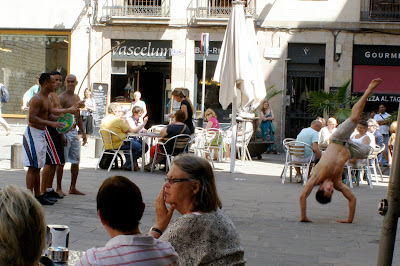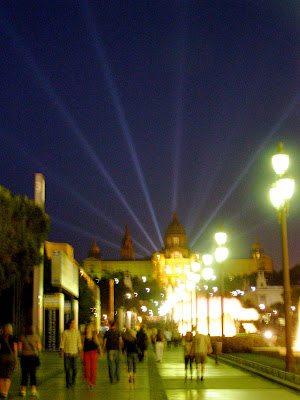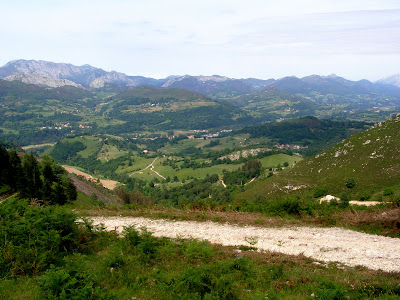




Montjuïc is also the part of town where the Olympic Games were held in 1992. It's home to the majority of the sporting facilities, like the pool and the stadium. I'm not sure if they're being used for anything else now, but they're still there:

On the way back down from Montjuïc, I decided to catch a bus to the Plaza de España, which is a big transportation hub on the south side of town, just to see a different part of town. What I didn't know was that the plaza was also very close to the national palace, which was an impressive sight getting off at the bus stop. It now houses the Museu Nacional d'Art de Catalunya, so I didn't go inside, but I did climb all the stairs up to the palace entrance. Its higher vantage offered other good views of the surrounding cityscape, and the cloudy sky made for some cool, ominous-looking photos:



For my last day in Barcelona, I got a relatively early start on the day and walked through the more well-known parts of town, from the coast inward. First stop was the monument to Cristobal Colón (Christopher Columbus), which stands in the middle of a round-about on a waterfront road. He's pointing out towards the ocean, presumably in the direction of the beginning of his journey:

The monumento a Colón stands at the end of Calle La Rambla, a pedestrian zone running through the heart of Barcelona. It's lined with shops and street vendors, as well as plenty of people. It's a pleasant walk, shaded by trees and providing tempting glimpses of side streets as they curve away from La Rambla. About halfway to Plaza Catalunya, where La Rambla ends, I found a big covered market, reminiscent of the ones I loved in Oaxaca. Stalls were filled with fruits and vegetables and nuts and meats and cheeses. There were also seafood vendors with their day's fresh catch...most of the crustaceans were still stirring even as they lay in the ice on display. I definitely saw more than one person jump as they walked by a "dead" lobster and suddenly it moved.



Soon after perusing the market, I reached Plaza Catalunya, located at the center of Barcelona. Before branching off into the Barri Gòtic (Gothic neighborhood), I couldn't help but laugh at the little kids scaring all the pigeons...especially funny because it's something I do too.


Then I ventured into the Gothic part of town, characterized by narrow streets lined with stone buildings at least a few stories high. This definitely had a different feel to it, and it felt like it belonged to a completely different city. I discovered this feeling more and more as I explored the various areas of Barcelona. I wound my way through the Gothic neighborhood until I reached the Gothic cathedral, which has the reputation of being a very impressive building. Unfortunately, I wasn't allowed to go inside because I was wearing shorts, but the doorman was nice enough to let me stand in the entryway and look at and take pictures of what I could from there. With the number of people going in and out, I easily could have snuck into the cathedral, but I didn't want to be disrespectful. I managed to get a decent shot of the main nave from the doorway:


Next, I went into the gardens behind the cathedral, which were small but pretty. And what did I find there but an egg dancing atop a thin spout of water. This is a tradition that apparently comes from a Eastern myth that took hold in Catalonia. According to the myth, as long as the egg is dancing, the region will prosper. It must have some importance within the Church and local culture, because the small fountain that supported this spectacle was surrounded by large flower garlands and trellises.


Upon leaving the gardens and the dancing egg behind, I turned a corner to find a bridge running over the street between two buildings. Although I'm not sure what the structure's original purpose was, it reminded me of the Bridge of Sighs in Venice (although I hope it served a less sinister function).

Passing under the bridge and continuing for a couple more blocks, I came upon a plaza filled with people protesting Spain's solution to the financial crisis and budget deficits. From the little I know about it, the government plans to cut salaries of its workers in order to save money. While this is fine for the higher-ups who live a cushy life as it is, it doesn't bode so well for teachers, doctors, transportation workers, etc. Therefore, there have been protests like this all over the country.

Walking around a little more, I found the Plaza del Rey and the steps atop which the Catholic kings welcomed Cristobal Colón back from the Americas. (Random fact: when this happened, the Gothic cathedral was already 800 years old).

Wandering further in the direction of the sea, I passed into the Born area of Barcelona, which has even more funky character than the Gothic neighborhood. Its streets are just as narrow, but they house eccentric shops and restaurants, and plant boxes galore reside in upper-story balconies.


Here, I visited the Picasso Museum, which detailed the beginnings of Picasso's life and work, focusing on the time he spent in Barcelona. While it didn't house any of his most famous paintings, it was interesting to see the beginning of Picasso's painting, and how his original style was very different than that of his iconic Cubist works. He went through a few periods of experimentation with colors and quite a few moves between Spain and Paris before he delved into Cubism, which he finally did in the early 1900s. Picasso was also a sculptor/potter, and the museum had some of his ceramic works on display.
It's also in the Born part of the city that the church Santa Maria del Mar sits, and true to the character of the area, just in front of the church is a small plaza surrounded by ice cream and coffee shops where traveling artists put on performances. While I was there waiting for the church to reopen for afternoon visitation, a group of four guys came along with a hand drum and a berimbau (a Brazilian instrument resembling a bow) and did some acrobatics and capoeira. They were all good at what they did, and I can't imagine the impacts their feet must have felt on the stone floor of the plaza. I also found the advertising directly in front of the church to be somewhat ironic, especially considering my experience at the Gothic cathedral earlier in the day (although they weren't as strict at Santa Maria del Mar).



The interior of Santa Maria was beautiful, although not quite what I expected, for all the talk I heard about it. The church itself was pretty simple, and very similar to any other church of the time period. It did, however, have gorgeous stained glass windows, and their designs even strayed from the traditional biblical depictions (there were, for instance, windows dedicated to the sun and the moon). The rose window was the most intricate one in the church:

After Santa Maria del Mar, it was time to relax on the beach for a couple hours. Since I was there on my own I didn't get to swim much, but the girls next to me were nice enough to watch my bags while I went for a quick dip. Now I've swum in the Mediterranean!


That evening, I went with a few friends from my hostel back to the National Palace to see la Fuente Mágica (the Magic Fountain). It was a programmed show with lights and accompanying music. Against the backdrop of the palace and the city, it was pretty cool.




Whew. That takes me up to early Friday morning, when I got in a taxi to get on a bus to get on a plane to get on a bus to get to Gijón to visit Andrew! The view from the air was pretty cool: misty mountain and the Pyrenees.



I spent five days in and around Gijón, exploring the sights of Asturias. For the first day we didn't do much. Andrew met me at the bus station and we walked back to his flat while he gave me a bit of a scenic tour of the city. He and his flatmates really do live right in front of the beach. The view from their living room window is pretty nice:

Gijón is actually something like the fourth most populous city in Spain, but it doesn't feel like it when you walk around downtown. It feels smaller than Salamanca, but has far more people living within its boundaries (220,000 as opposed to 170,000). In the afternoon, we took it easy, made some food and then opted for a siesta on the beach. It was a cloudy day so the sun wasn't too hot, but the air was warm enough for swimsuits. After napping for a couple hours, we met up with some of his friends and played some American football (I would have rather played real football, but as it was, one of the guys had just gotten an American football and was consequently very excited to play with it). We played 3-on-3 for a couple of hours until dinner time, and then met back up on the beach later on in the evening to hang out. Andrew is the only guy from the U.S. studying in Gijón, and the rest of the people in his group of friends are from elsewhere in Europe, studying abroad through the Erasmus program. Everyone I met was really nice, and we all had fun together.
My second day there was an exploratory one...Andrew and I took a bus to a point about eight kilometers away from town and walked all the way back along various beaches and trails. It was another cloudy day, but again, not too cold, and the coast was beautiful (it lived up to its Spanish name, la Costa Verde).







After walking around all day, we went with a group of friends to another beach for a barbeque. This beach, Xago, was fairly big and had some good waves, so quite a few people were out surfing. We watched them into the evening, and then started up the grill and cooked and ate for a couple hours. Good food, good company, good fun.
The next day was also somewhat cloudy, so we opted for a day trip to Oviedo, which is 28 kilometers away from Gijón (for anyone who's seen "Vicki Cristina Barcelona", Oviedo is the place they go for the weekend). We hiked up Monte Naranco (all 600 some meters of it) and saw two ninth-century churches along the way, Santa María del Naranco and San Miguel de Lillo. Atop the monte is a large statue of Jesus which is pretty impressive, but since it was super windy up there, we didn't stay for long.







Once we came back down from Naranco, we wandered around Oviedo a bit. Andrew had been there many times before for classes and with friends, so he took me on a sort of tour around the old city center. We saw a statue tribute to Woody Allen (the director of Vicky Cristina Barcelona), as well as a bunch of other abstract statues. We also went to Oviedo's cathedral, although it was unfortunately closed because it was Sunday afternoon. However, the exterior of the building was beautiful.


Our next adventure took us to Cangas de Onís, a small mountain town that prides itself as being the gateway to the Parque Nacional Picos de Europa. Cangas reminded me quite a bit of Salida, in that it's a small mountainous river town that relies very heavily on tourism, but otherwise has a sleepy and relaxed ambience. There are two rivers that run through it...the Río Sella and the Río Güeña. The Sella was beautiful, with cristal clear turquoise water. As it ran underneath an old Roman bridge, I couldn't help but think of a scene out of the LOTR films...Rivendell, perhaps? Andrew and I explored the town for a bit and then decided to head up into the hills to see if we could find a lookout point about five kilometers away. The climb was relatively steep, and with the sun out, it made for some good exercise. We climbed all the way through Cangas until we reached the área recreativo above the city, and then continued on from there on a network of windy narrow dirt roads. Although we never reached the official lookout point, we did have some great views along the way, and wandered around numerous fields and pastures, just to see what we would find. We walked up the sort of spine of one of the hills, where we could see beautiful terrain on both sides of us. We could see the Río Sella slicing through a valley far below us, and the mountains that sloped upwards from the river were somewhat reminiscent of Andean lands.








In all of our adventuring around Asturias, Andrew and I always packed lunches to take with us, and that's how I stumbled upon this valuable fact: Asturian cheese is really good. The people make many different varieties, ranging from soft to hard, and using any combination of goat, cow, and sheep milk. And they all have a delicious strong flavor. Yum.
It was great to see Andrew again, but yesterday we parted ways and I arrived here, in Santiago de Compostela. I'll be here through tomorrow evening, at which point I'll hop on an overnight bus to San Sebastian, where I'll spend the weekend with a bunch of friends from CC. It's been rainy the whole time I've been here, so I haven't done as much as I would have liked thus far. However, the hostel I'm staying at is very cool, as are the people I've met here, so we've gone on short excursions together and spent quite a bit of time sitting around and talking. I also figured it was an opportune time to post an update here. For now, though, I'll leave it at this. This blog is already turning into an encyclopedia. Take care, be great.
No comments:
Post a Comment